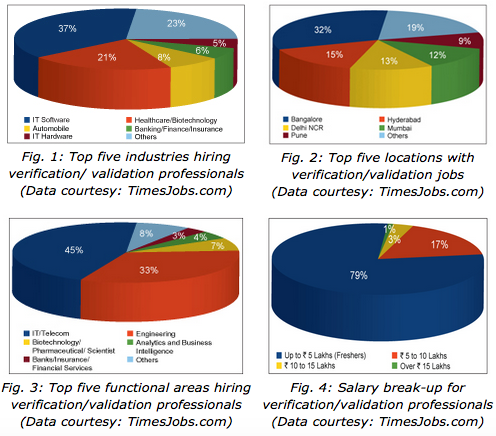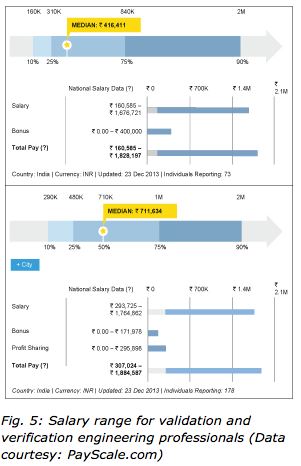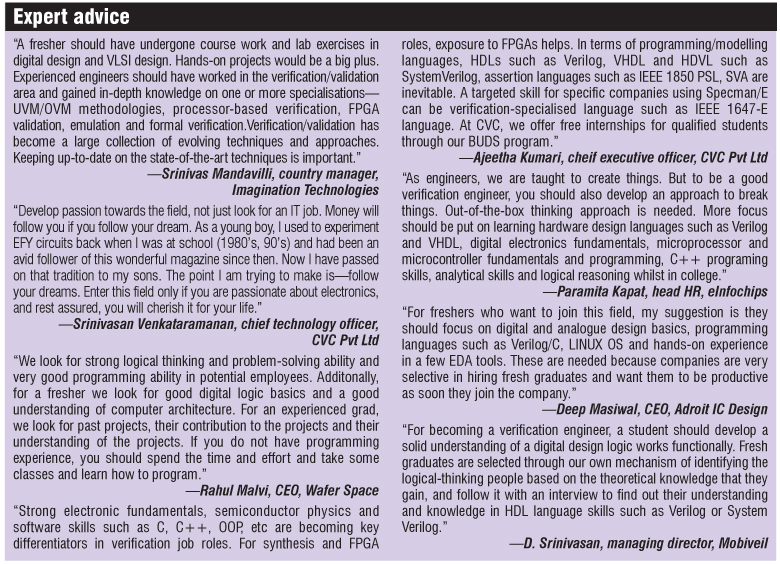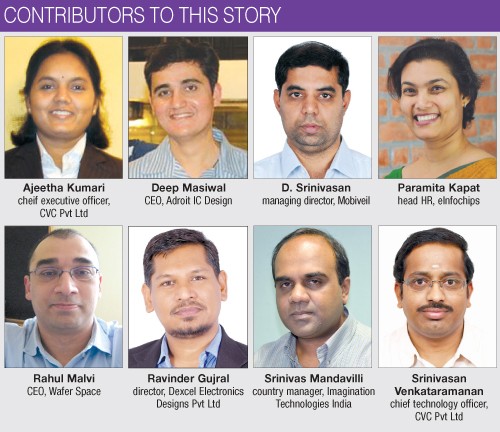Sometimes used interchangeably, verification and validation ensure that the system being created will meet the requirements of the customer. When the specifications are validated and the system is verified against the specifications, the concluding system fulfills its purpose. Sounds simple, right? But it is pretty challenging and demanding being a verification and validation engineer.
“The purpose of verification and validation is to ensure ‘first time right silicon’ or few silicon revisions, as revisions are costly in terms of money, effort and time. To ensure correct functionality, designs need to be validated across various parameters, which involves different types of analysis,” says Deep Masiwal, CEO, Adroit IC Design.
From ensuring ‘does this thing work right’ (verification) aspect to ‘you built the right thing’ (validation), these engineers ensure designs meet requirements and experience the pain of product reworks, pressure of meeting deadlines for the products to be released as per customers’ demands, ensure the verification and validation processes are effective, avoid additonal expenses and delays, ensure product quality and reduce prototyping costs.

Scope
There is an excellent scope and opportunity in the field of verification and validation believes Rahul Malvi, CEO, Wafer Space. Talking about verification, he says, “Verification occupies the largest portion of the design cycle and, with the size of designs today, it gets more and more complex and critical to the success of the semiconductor vendor.”
On a similar note, Srinivas Mandavilli, country manager, Imagination Technologies India believes that SoC designs are only to get larger and more complex. He says, “In many cases, verification consumes more than 70 per cent of the total design effort. Opportunities in verification and validation are going to increase over the next few years and get more specialised.”
Masiwal says, “The total percentage of verification and validation projects carried out in India is 50-60 per cent, which is a pretty big number and highlights its significance in the industry. One can make a very good career in this field.”
“A person who gets into verification and validation has a holistic view of the design at a very early stage of his/her career, and this opens up a wide career path. With this exposure, the person has an option to switch to design phase to become a very good systems architect who understands full systems perspective from functional to error scenarios, which can be taken care in the early design,” says D. Srinivasan, managing director, Mobiveil.
It is fundamental to appreciate this fact that, in general, the number of designs that start from scratch has been on a decline for a few years now, across this industry, believes Srinivasan Venkataramanan, chief technology officer, CVC Pvt Ltd. He says, “It is not a bad scene but rather a reflection of market which demands more and more integrated devices such as smartphones and chipsets, and ever-shrinking time-to-market schedules. Hence the term ‘designers’ in modern day refers to a wide spectrum of engineers in verification/validation domain such as system integrators, RTL block owners, modifiers, verification environment designers, etc as each one of them do look at some key aspects of the design.”
Entry-level opportunities
Masiwal informs that for freshers, the opportunities are in two areas, namely, ASIC functional verification and memory IO, and analogue IP validations/characterisation/layout. He says, “The fresher is a part of a team consisting of seniors and is expected to understand the design, validate and simulate the design, run functional checks and ramp up fast. Our company expects fresh graduates to have good knowledge of analogue and digital design fundamentals.”
Whether there are opportunities for senior, junior or fresher, one needs to appreciate the market demands to chalk out their career path in any domain, believes Ajeetha Kumari, chief executive officer, CVC Pvt Ltd. Coming to this specific domain, she says, “Typically freshers are seen as out-of-the-box thinkers, smart engineers with innovative mindsets and zeal to learn new skills, and they are also realised as part of the ‘market segment’ as they are one of the biggest consumers and market drivers for many of these hardware devices being designed/developed.”
With verification dominating the ASIC design project cycles, she further adds, “The term ‘verification engineers’ gets often further classified to verification environment developers, verification owners/execution engineers, regression owners and coverage closure engineers, coverage model developers and assertion developers, formal verification engineers. However, there is also a steady intake of FPGA RTL designers.”
Talking about the entry-level roles for freshers, Paramita Kapat, head HR, eInfochips shares, “Entry-level roles and responsibilities, in the services companies who provide their verification services to product companies, will include—maintaining the regression suite, running the regression and reporting the results to the team, owning some small block verification, writing test cases and debugging the failures, etc.”
Demand areas
Talking about the top functional areas and geographical locations, Vivek Madhukar, COO, TBSL, which operates TimesJobs.com explained, “Validation and verification is also known as quality assurance (QA) and quality control (QC) in industry parlance. QA/QC jobs are highly specialised in nature and are expected to be in demand in the near future, as they form an integral function in all sectors employing high-end electronic equipment. It is therefore quite evident that the IT, telecom, engineering and biotech sectors appear to be the biggest recruiters of these professionals. In terms of locations, the four major metros—Bangalore, Hyderabad, Delhi and Mumbai—account for most of the demand.”

According to the data provided by TimesJobs.com, the major share of the jobs available are in functional areas such as IT/telecom, which constitues about 45 per cent, and engineering is about 33 per cent. The remaining are scattered amongst other areas such as healthcare/biotechnology, banks, etc.
The top industries hiring verification and validation engineers are, of course, the IT software industry with about 37 per cent share of jobs followed by the healthcare/biotech industry with a share of 21 per cent. Automobile, banking/financial services and IT hardware industries offer 8 per cent, 6 per cent and 5 per cent of the jobs, respectively. Remaining 13 per cent of the jobs are scattered amongst different sectors.
Apart from Bangalore, Hyderabad and Delhi that feature in the list of top locations for verification and validation jobs with 32 per cent, 15 per cent and 13 per cent, respectively, Mumbai and Pune are emerging cities with 12 per cent and 9 per cent of the jobs, respectively.
Pay package
As found on payscale.com, the average salary for a design verification engineer is Rs 711,635 per year. People in this job generally do not have more than 10 years’ experience. A skill in Perl is associated with high pay for this job. A validation engineer earns an average salary of Rs 416,412 per year.
Usually, for beginners in this field, the pay package is up to Rs 500,000 annually with 79 per cent jobs available for this salary range.
Juniors get anywhere between a half to one million rupees, mid-level experts draw something between one and 1.5 million and the seniors are paid anything above 1.5 million as per TimesJobs’ statistics.

Talking about CVC, Venkataramanan, shares, “Our company is a VLSI ecosystem company—one that enables a vibrant VLSI ecosystem through our innovative approach to incubating role-based engineers, both freshers and the experienced alike. Hence we enable lot of freshers (approximately 150-200 engineers per year) to enter this domain.
“We also enable high-end EDA technology deployment in India (for US-based EDA start-ups) and hence we require workforce that we typically hire from freshers lot. The pay package starts around Rs 2,40,000 per annum but big product companies pay as high as one million per annum, though they hire mostly from IITs, NITs, etc. However, it is very important to realise the steep jump in the pay package in this domain (against the likes of SW siblings). Typically, after 1-2 years experience, our own CVC employees get hired for salaries as high as Rs 6,00,000 per annum.” eInfochips too recruits freshers for this domain offering a pay package of anything between 2,00,000 and 3,00,000 rupees per annum.

Talking about Adroit IC Design, Masiwal says, “Our company is very selective in hiring freshers and we prefer candidates to have prior internship experience of at least six months. Fresh graduates’ pay package varies from Rs 4,00,000 to 6,00,000 per annum. Based on type of degree and experience, professionals’ pay package is a mix of fixed salary (Rs 6,00,000 to 20,00,000 per annum), company shares, and performance bonuses.” On a similar note, Ravinder Gujral, director, Dexcel Electronics Designs Pvt Ltd shares, “We always look out for bright engineers in the area like FPGA/ASIC design and verification along with board design and embedded software. The salary range for verification and validation engineers usually depends on their technical aptitude and experience. Engineers with around 2-3 years of experience typically get salary around 5,00,000 to 7,00,000 rupees per annum.”
It is not just programming
Ensuring that designs meet requirements could be a challenging task, but a career in this field has its own rewards and perks. VLSI/semiconductor domain has been a vibrant, albeit small field (relative to its software sibling) since last 15+ years in India, believes Ajeetha Kumari. She says, “It is driven by passionate electronics engineers than by just those who seek some quick success.”
In brief, this domain requires engineers with deep electronics knowledge and also various other skills in adjacent domains.






